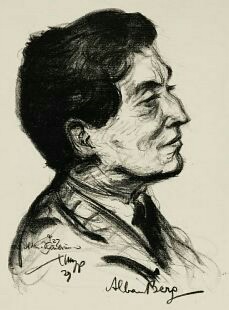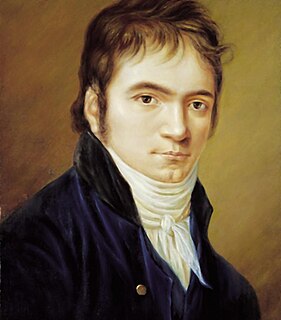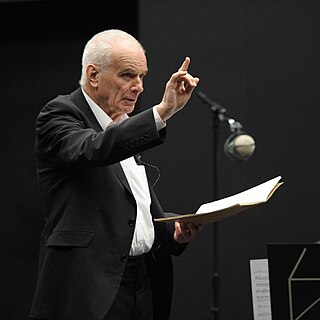
Alban Berg's Violin Concerto was written in 1935. It is probably Berg's best-known and most frequently performed instrumental piece, in which the composer sought to reconcile diatonicism and dodecaphony. Berg composed it on a commission from Louis Krasner, and it became the last work that he completed. Krasner performed the solo part in the premiere at the Palau de la Música Catalana, Barcelona on 19 April 1936, after the composer's death.

The Violin Concerto in D major, Op. 77, was composed by Johannes Brahms in 1878 and dedicated to his friend, the violinist Joseph Joachim. It is Brahms's only violin concerto, and, according to Joachim, one of the four great German violin concerti:
The Germans have four violin concertos. The greatest, most uncompromising is Beethoven's. The one by Brahms vies with it in seriousness. The richest, the most seductive, was written by Max Bruch. But the most inward, the heart's jewel, is Mendelssohn's.

The Symphony No. 2 in D major, Op. 36, is a symphony in four movements written by Ludwig van Beethoven between 1801 and 1802. The work is dedicated to Karl Alois, Prince Lichnowsky.

Edward Elgar's Cello Concerto in E minor, Op. 85, his last notable work, is a cornerstone of the solo cello repertoire. Elgar composed it in the aftermath of the First World War, when his music had already gone out of fashion with the concert-going public. In contrast with Elgar's earlier Violin Concerto, which is lyrical and passionate, the Cello Concerto is for the most part contemplative and elegiac.

Ulvi Cemal Erkin was a member of the pioneer group of symphonic composers in Turkey, born in the period 1904–1910, who later came to be called The Turkish Five. These composers set out the direction of music in the newly established Turkish Republic. These composers distinguished themselves with their use of Turkish folk music and modal elements in an entirely western symphonic style.
The Violin Concerto No. 3 in G major, K. 216, was composed by Wolfgang Amadeus Mozart in Salzburg in 1775. Mozart was only 19 at the time.

Symphony No. 2 in E minor, Op. 27 is a symphony by the Russian composer Sergei Rachmaninoff, written in 1906–07. The premiere was conducted by the composer himself in Saint Petersburg on 8 February 1908. Its duration is approximately 60 minutes when performed uncut; cut performances can be as short as 35 minutes. The score is dedicated to Sergei Taneyev, a Russian composer, teacher, theorist, author, and pupil of Pyotr Ilyich Tchaikovsky. Alongside his Piano Concerto No. 2 and Piano Concerto No. 3, this symphony remains one of the composer's best known compositions.
The Cello Concerto No. 1 in C major, Hob. VIIb/1, by Joseph Haydn was composed around 1761-65 for longtime friend Joseph Franz Weigl, then the principal cellist of Prince Nicolaus's Esterházy Orchestra.

The Concerti Grossi, Op. 6, or Twelve Grand Concertos, HWV 319–330, are 12 concerti grossi by George Frideric Handel for a concertino trio of two violins and violoncello and a ripieno four-part string orchestra with harpsichord continuo. First published by subscription in London by John Walsh in 1739, in the second edition of 1741 they became Handel's Opus 6. Taking the older concerto da chiesa and concerto da camera of Arcangelo Corelli as models, rather than the later three-movement Venetian concerto of Antonio Vivaldi favoured by Johann Sebastian Bach, they were written to be played during performances of Handel's oratorios and odes. Despite the conventional model, Handel incorporated in the movements the full range of his compositional styles, including trio sonatas, operatic arias, French overtures, Italian sinfonias, airs, fugues, themes and variations and a variety of dances. The concertos were largely composed of new material: they are amongst the finest examples in the genre of baroque concerto grosso.
The Symphony No. 5 by Walter Piston was composed in 1954.
The Symphony No. 7 by Walter Piston is a symphony dating from 1960.

The Symphony No. 3 by Peter Maxwell Davies was composed in 1984 on a commission from the BBC Philharmonic, who gave the world premiere on 19 February 1985, at the Free Trade Hall in Manchester, with Edward Downes conducting.

The Symphony No. 4 by Peter Maxwell Davies was commissioned for the Scottish Chamber Orchestra by Christian Salvesen plc and composed in 1989. It is dedicated to the memory of the violinist John Tunnell, who had been leader of the orchestra, and was premiered at the Royal Albert Hall on a BBC Promenade Concert on 10 September 1989, with the composer conducting the Scottish Chamber Orchestra.
Symphony No. 50, Op. 360, Mount St. Helens is a three-movement orchestral composition by the American composer Alan Hovhaness. The symphony was commissioned by former Hovhaness publisher C.F. Peters and was completed January 24, 1982. It premiered March 2, 1984, and was performed by the San Jose Symphony under conductor George Cleve. The piece commemorates the volcano Mount St. Helens, culminating in the events of its 1980 eruption, which Hovhaness had witnessed from his Seattle home.
The Symphony No. 22, Op. 236, City of Light is a four-movement symphony for orchestra by the American composer Alan Hovhaness. The work was commissioned by the Birmingham Symphony Orchestra for the centennial of Birmingham, Alabama and was completed in 1970. The work has been recorded multiple times and remains one of Hovhaness's more popular compositions.
The Symphony No. 66, Op. 428, Hymn to Glacier Peak is an orchestral composition in three movements and the penultimate symphony by the American composer Alan Hovhaness. The work was commissioned by the Seattle Youth Symphony Orchestra and was completed in 1992, shortly before its premiere by the Seattle Youth Symphony, conducted by Ruben Gurevich, at the Seattle Opera House on May 10, 1992. The title of the work comes from the stratovolcano Glacier Peak in the Cascade Range, visible from Hovhaness's home in Seattle, Washington.
The Guitar Concerto No. 2, Op. 394, is a concerto for classical guitar and string orchestra by the American composer Alan Hovhaness. The work was commissioned by the Spanish guitarist Narciso Yepes. It was completed in June 1985 and later premiered at the Granada Festival in 1990.
The Guitar Concerto No. 1, Op. 325, is a concerto for classical guitar and orchestra by the American composer Alan Hovhaness. The work was commissioned by the SRO Production Performing Artist Management and the Minnesota Orchestra for the guitarist Javier Calderon in July 1978. It was completed January 21, 1979, and was premiered later that summer by Calderon and the Minnesota Orchestra under conductor Leonard Slatkin.
The Symphony No. 63, Op. 411, Loon Lake is a symphony for orchestra in two movements by the American composer Alan Hovhaness. The work was commissioned in September 1987 by the New Hampshire Music Festival and the Loon Preservation Society. It was completed in early 1988 and premiered August 18, 1988, with conductor Thomas Nee leading the New Hampshire Music Festival Orchestra. The ending of the piece was later revised by Hovhaness at the request of his wife; the revised symphony premiered July 2, 1991, and is the only version available on recording.
The Symphonia: sum fluxae pretium spei is an orchestral triptych by the American composer Elliott Carter. Its three movements were composed between 1993 and 1995. The complete work was first performed on April 25, 1998 at Bridgewater Hall, Manchester by the BBC Symphony Orchestra under the conductor Oliver Knussen. The second movement "Adagio tenebroso" was a finalist for the 1996 Pulitzer Prize for Music.













